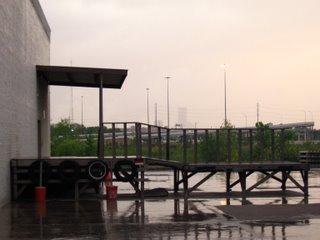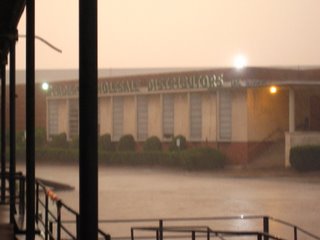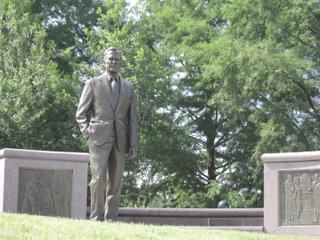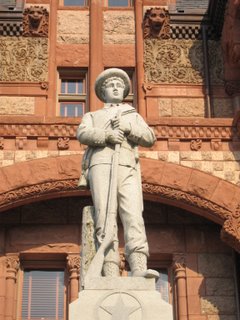How do you remake a city?
Or, How do you memorialize a city?
Or, How do you forget a city?
How do you remake a city?
Or, How do you memorialize a city?
Or, How do you forget a city?
Schedules here are more like suggestions. Snapping turtles plod across the road, alligators swim lazily in the swamps, and 3 o'clock swamp tours begin at 3:45. In Kraemer the drawbridge operator regularly falls asleep in the control house, and if you're on the water, you may have to call your friend next door to wake him up.
The pile of useless alligator skulls has been accumulating, under a corrugated tin roof, for 20 years. Once there was a market for the heads, as tourist souvenirs in New Orleans, in Mississippi, in Florida, but now only the meat is salable. So the heads sit, unmoved, even by Hurricane Katrina, destroyer of New Orleans.










Julian, a British reporter on extended holiday, comes with me to St. Charles Parish because I have told him that I am going to see the grave of Hitler's horse and a bathtub that used to belong to Zachary Taylor. Julian doesn't know who Zachary Taylor is, which I think is reasonable. Still, the potential historical ephemera entices him away from the Confederate Civil War Museum in New Orleans.
"How did Hitler's horse get to Louisiana?" Julian asks.
"It might not actually be Hitler's horse," I say. I tell Julian that I suppose we're going to the supposed grave of Hitler's horse. Or the grave of Hitler's supposed horse. Or something.
Nevertheless, Julian comes anyway.
The grave of Hitler's horse (“Nordlicht”) is at the La Branche Plantation, just outside St. Rose. I call them on the phone just after 10 am, to be sure that they're open. The message indicates that they're open every day, starting at 10 am. Still, the fact that they don't pick up the phone is a bad sign.
When we get to the plantation, there is no one around, so I pull onto the grass and park. Outside it is steamy and hot--in a couple hours we will pass a bank sign with the temperature, and it will read 99 degrees. Now, though, we get out and walk slowly, and even after a few steps in the sun I can feel my shirt sticking to me. In the West, the sun heats the ground; here, the sun heats the air.
We wander behind a shed--or perhaps a former kitchen, or slave quarters, or some other historic building built haphazardly--and find a small corral surrounded by a coarse, two-bar wooden fence. Inside are three girls on horses practicing dressage, and their instructor, a squat woman in her mid-40s. The girls and horses make upright circles, and the woman barks corrections at them.
"This doesn't look like a plantation tour," I say.
{ "Can I help you?" the woman in the middle says.
"Well, we're here, we should still ask," Julian says.
"Excuse me, miss" I shout, "we were just looking to take a tour of the plantation."
You shouldn't be here, she shouts back. The plantation's only open on weekends.
"I did call," I say. “The answering machine said it's open.”
"I don't know what's on the message." she says, "That's from before the storm. The plantation's closed."
And that's that.
But Julian still wants to see the grave of Hitler's horse, so after a few steps, he turns back to her.
“I really don't have time for this right now,” the woman says when Julian asks where the grave might be. She turns toward the middle of the pasture, then turns again to us.
“You know, there are No Trespassing signs,” she says. “I don't know what you think you're doing by coming back here, but I don't think you want me to bring the police round.” Julian and I look at each other, but neither of us reply.
“So much for Southern hospitality,” Julian says, to me, softly.
On the way out, we look for any sort of No Trespassing sign, but they are nowhere to be found.
Houston is home to a guerrilla marketing campaign whose slogan—"Houston. It's Worth It."—means exactly what you think it might mean but aren't completely sure. It makes sense, though. Most of the young people you meet in Houston are from Houston, or from somewhere where Houston is somewhere: Huntsville, Liberty, Pasadena, China; towns named after other places. The idea is more to keep talent from leaving Houston than attracting it from elsewhere. At least, attracting it to Houston as a destination city; the oil wealth has always brought some people here.
In the marketing materials there's even a list of 20 things that are worth it:
The heat The humidity The hurricanes The flying cockroaches The mosquitoes The traffic The construction The sprawl The refineries The ridicule The pollen The air The billboard The flooding The image The property taxes The short springs The long summers The potholes The no mountains
The idea, at least partially, is to create goodwill through this sort of self-deprecation. For it's easy to like anyone, or any place, that doesn't take itself too seriously. "I like places with low self-esteem," says Benji Mason, whose couch I sleep on for a few nights after I show up at Third Ward Bikes, one of Workshop Houston's workshops. Benji's an artist-in-residence at DiverseWorks and an employee at Workshop Houston, which runs a number of programs for teenagers in the Third Ward. He's smart and interesting, and seems to enjoy his life here. More importantly, Benji's a transplant: he's a Vermonter.
There are good things about Houston that are obvious to outsiders. The Menil Collection, for one, all of which is free. This includes the Rothko Chapel, a small, non-denominational building “inspired by the paintings of American abstract expressionist Mark Rothko,” whose has a number of canvases therein; the main Menil collection; a collection of Cy Twombly's work; and the Byzantine Chapel, which contains the fresco of a small Cypriot chapel with the blessing of the Church of Cyprus and the Turkish government.
Likewise, the medical care in Houston is reputed to be first rate, and Rice University also has a good reputation. (Rice students have a reputation in Houston for being spoiled and impractical, however.)
At lunchtime at Third Ward Bikes, Benji drives first to a taco stand, which is closed, and then to a Vietnamese sandwich shop. “There's a lot of money in Houston and not that much, compared to places like New York or San Francisco, to spend it on,” he says to explain Workshop Houston's funding success. Their annual budget is around $120,000. “You go to San Francisco and try to start a new program, and there's already so many other good programs out there.”
This I already know. The community bike shop where I volunteer, the Bike Kitchen, has an annual budget of around $10,000 and no paid staff members. The shop has been around for almost as long as Benji's—by our calculations, about six months less. This opportunity, perversely, is one of the things Benji likes. “It's wide open here,” he says, and gestures toward the cluster of larger high-rises that comprise downtown. “The cool thing is, if you want to start something cool, you can get a lot of support.”
I don't think Benji has a skewed view of Houston. One of his acquaintances, Jeff, is a musician and computer programmer at NASA. He has offered to give the shop whatever money it needs. “I told them, 'Just let me know,'” Jeff says. “If they need ten thousand, I could probably come up with it.” Jeff's not particularly wealthy either, but he wants to give back to his community. Oh, and he's 30.
Still, Benji can't imagine staying indefinitely. "I've been here since graduation" from college in 2002, he says. "I'll probably leave in another year or two." Where to? “Maybe Philadelphia,” Benji says. It's another city with low self-esteem.

At the sandwich shop, everything costs $2.50. I consider buying two, because I am not sure of the size. As we wait, I mention to Benji that I'm so impressed you can buy a 24 oz. Shiner Bock at a liquor store for $2. “The thing is, in Texas, that's not a cheap beer,” he says. There's a bar near him that serves Pabst Blue Ribbon—PBR, popular because it's inoffensive and inexpensive—for 85 cents. Shiner Bock wouldn't even come up as a cheap beer here, where at home in San Francisco, generally, a six-pack of cans is $6 and bottles is $8 or so.
The sandwiches are good, and large enough, certainly much larger than I expect. We drive through a “little” storm on the way back to the bike shop. The day I leave Houston, three days from now, I-45 will essentially be shut down from flooding from this same storm system, and I-10 will be marked by inaccurate signs that say the highway is closed just ahead.
“When I first got here, Zach”—one of the other founders of Third Ward Bikes—“had to teach me flood driving,” Benji says. “Try to stay to the center of the road. Don't drive too slow, but don't drive too fast either, because that's an asshole move that makes waves.” I look at him, but he's concentrating on driving. “Basically go where you need to go,” he says.

Because of the rain the shop is quiet. There's one small kid fiddling with his brakes. “Do you get Vietnamese sandwiches in San Francisco?” one of the mechanics asks. His mouth is full, so the words come out in a rounded jumble. He's a graduate of the University of Houston and a native of the city. Indeed, he's never lived anywhere else.
I tell him that's there's at least one shop I can think of, and maybe more, but you have to seek them out, mostly. Not this cheap, though.
He nods, happy that Houston wins out somewhere, somehow.

HOUSTON (AP) - A university student scaling the southwest corner of one of Houston's best-known skyscrapers jumped about 30 stories to his death Monday morning.
The student, identified by police as Ryan Hartley, 20, was about halfway up the 901-foot, 64-story Williams Tower when he leaped about 7:45 a.m., Houston Fire Department spokesman Jay Evans said.
Police recovered a driver's license and a note containing a message of a political nature. Authorities have declined to reveal details of the note, other than to say it did not mention plans to jump. The Harris County Medical Examiner's Office ruled his death a suicide Monday.
Hartley attended the University of Houston, having transferred from the University of Texas this fall semester, said Michael Cinelli, a spokesman for the Houston school.
Authorities said it did not appear that Hartley used any harnesses, belts or suction cups.
"He did not have any of the normal professional equipment you'd normally see on someone trying to climb a building," Evans said.
Hartley was wearing a powder bag on his waist, using it to apply rosin to his hands, and also employed some sort of handheld pick on the window molding as he moved higher.
—published in The Amarillo Globe-News, The Abilene Reporter News, The Sunday Mail (Sydney, Austrailia), click2houston.com, and others, December 17, 2002.
*
Protesters in the anti-war movement often express concern that bystander civilians would be a significant portion of the casualties caused by a major strike on Iraq.
Outspoken anti-war activists have taken different approaches to show their discomfort with what the U.S. military calls "collateral damage." Some, through non-violent means, while others through more risky forms of defiance.
"This Country has been fighting a war to impose their flawed sense of democracy, to many nations against their will, in such a manner the U.S. looks after the aims of their economy and inserts a powerful force against the affairs of the U.N."
That was Kevin Hartley, reading from a letter written by his brother Ryan Hartley.
This letter was found last December in Houston, after Ryan, an experienced rock climber, decided to climb the Williams tower in order to demonstrate his opposition to the war against Iraq.
When Ryan's hands were wounded by the sharp edges on the building while climbing, he lost his grip. He then fell 30 stories to his death.
Kevin Hartley has investigated his brother writings and thought patterns.
Contrary to mainstream news reports that portrayed Ryan as a suicide victim, Kevin argues Ryan's anti-war sentiments were a mixture of Christian peace-maker zeal and a mental imbalance that had affected him for years.
"You have to let your voice be heard, you also got to do that in a manner of Love, you have to show an alternative to the Hatred."
Kevin says his brother was fighting for peace and that even though he had mental problems, Ryan wanted to make a loud statement by climbing the tower.
A memorial service for Ryan was held at Second Baptist, one of the Mega Churches in Houston where his mother is an active member.
Kevin is a deacon at a contemporary church in the Montrose area called Ecclesia. Like Ryan, he feels Christians should support peace rather than war.
"The best thing that could be done out of this situation is that people will hear a message of peace that they would not have heard otherwise, I thought that if anything out of this could be good. The fact that a message of peace could be preached at Second Baptist, this place where they heard nothing more than the Republican party line "War is the answer." If a few people can hear this message and understand what it said, his death was worth my grief and my families' grief, if it helped somebody not to support the killing of people across the world."
—David Daniel Gonzalez, KPFT News, Pacifica Radio Network, Houston. Broadcast on February 21, 2003.
We interrupt this regularly scheduled program to bring you a special announcement.
Yesterday the Chronicle published my review of Anthony Giardina's White Guys.
You can read it here.
Pretty much everything else in this post is adult content, so consider yourself warned. Another travel post will come soon enough.
*
Because the Chron is something of a family newspaper, the extended quote that I really wanted to use—where Tim O'Kane masturbates to the picture of a black model in Brides—couldn't really be included.
I sat on the closed cover of the toilet and tried to empty my mind. Three magazines were in a wicker basket next to the toilet. Boating, Modern Maturity, and Brides. I picked up Brides (it was the closest) and flipped through the succession of articles on wedding cakes, on dresses and floral arrangements, on gift ideas for the groomsmen. In the photographs, pastels dominated; the light was soft and the sun perpetual. There was a predominance of blondes, and the world seemed exclusively white. Even the very occasional black guests and the single black bride looked as if they had been dipped in the vat of the suburban, so that their color seemed an accident, a clung-to habit from earlier, less-prosperous days. Looking at them, I couldn't help but remember what Kenny had said about the story that the city embraced to explain Billy's and Patty's shootings: our fear of the dark one appearing out of nowhere, gunning for us. Not these. Not these clever, handsome men and this doe-eyed, full-lipped bride who gazed directly at me, who I wanted to fuck. I wanted to loosen my pants and unleash my already partially swollen dick and imagine those black lips parting to receive it. We would go inside this old stone house where her very white wedding was taking place, and I would fuck her blind. Jesus. I would fuck her back into her own blackness.
I dropped the magazine and tried to forcibly close off this line of thought. Already my hand had gone to my dick, already I was holding it, feeling its familiar distended skin. I was forty-one years old, too old for this, but did we ever stop looking for consolation this way? The desire to fuck a beautiful black model could at least remove me for a second or two from the impoverished life of being Tony Di Nardi's son-in-law, humiliated at a grand party because this confused, powerful man could not decide what he wanted. (pp. 213-4)
Much thanks to Rosa Miller, by the way, for helping me not embarrass myself in talking about the coded language that Tim O'Kane uses. Rosa, I really appreciate it.
The man himself is 5 foot 7. David Adickes, that is, the sculptor of the giant Sam Houston sculpture souths of Huntsville and of the giant presidents’ heads in Houston. His sculptures are significantly larger: Sam Houston, in Adickes’s rendering, is something like 67 feet tall.
No one in Houston really seems to know much about Adickes, at least no one I talked to. Everyone’s seen the heads, but they don’t really know how to get there. His workshop, with the giant concrete casts, is in a part of Houston that’s full of dead ends and non-continuous streets. But no matter: he leaves the gate open at his workshop, and at night, if you want, you can whisper sweet nothings into Martin Van Buren’s ear.





Until I read the chronology at the George H.W. Bush Monument, I had never realized how bad he was at actually being elected. Notable elected offices held:
Notable losses:
In between George (H.W.) was appointed to a great many things:
And, of course, his elected-appointment as Vice President (1980).
George (H.W.) was also acting president for 8 hours in 1985, as Reagan underwent colon surgery. Most of this time he spent playing tennis.
*
Behind the 8-foot tall George (H.W.) Bush statue at the George Bush Monument are four scenes from George (H.W.)'s life. In the first, he is dashingly donning his aviation gloves while sailors load or unload ammunition next to an airplane. In the second, George (H.W.) meets with some supporters—presumably oilmen, from the derrick in the background—while running for office, with his sleeves rolled and his jacket dapperly over one shoulder. In the third, he shakes Gorbachev's hand as the two of them watch a young German man take a sledgehammer to the Berlin Wall. In the last scene, and older George (H.W.) looks on, Barbara (I) beside him, as George (W.) is sworn in as president.
In every picture, George H.W. Bush watches someone else do the work.
The reason one comes to Waxahachie, other than necessity, is to see the courthouse. It's a beautiful building, and would be the center of town if anyone other than antique hunters went to the center of town.
The courthouse has a myth about it, that a German mason named Harry Herley fell in love with Mabel Frame, the daughter of his landlord in town. He began carving her portrait on the building to show his love. In some versions, his love in unrequited; in others, her father prevents them from being together. If you believe the former story, you can walk around the building and see Herley become embittered, and Mabel's face become more and more horrific. It's not true, even if there was a mason named Harry Herley who worked on the building, but it makes a good story, especially for tourists.

In front of the courthouse is a monument to the Confederate soldiers of Ellis County. A child-soldier stands atop it, his hands clutching a rifle. It reads:
In honor of
the dead and living
of Ellis County
who wore the gray.
Banners may be furled
but heroism lives forever.
Erected by the
Daughters of the
Confederacy,
unveiled Nov. 2, 1912
This world view, and the ethos that goes with it, are common in Texas. The Civil War (or, more commonly, the War between the States) wasn't about the "right" to enslave others, but about the nebulous concept of states' rights. And the soldiers weren't fighting on the Confederate side weren't fighting for slavery, but to prove their mettle in battle. The war was a means to an end, then: a means, since heroism lives forever, of earning immortality.
I don't mean to say that the Daughters of the Confederacy, or any similar organization, are out-and-out racists who want slavery revived. In Texas it may be socially acceptable to stridently vocalize reactionary political views, but the idea of "Southern heritage" is something else. If you measure racism by effect, by consequences rather than intent, you could present a strong argument that monuments like Waxahachie's are racist. But the more time you spend around the monuments, the more clear it becomes that any explicit racist intent is absent. Instead, I think, two desires dovetail into the preoccupations with the Confederate flag and "heritage violations" that one finds today.
The first is the romanticism—or romanticization—of the antebellum South. This is both a rosy view of crinolines and crinolettes, wool jacket and frock coats, as well as of the nobility of the aristocracy and the Lost Cause. Things were better then, obviously, and the architecture better, the people more noble.
The idea of the nobler past exists everywhere, for all time, so it's not really surprising here. Hesiod's Works and Days, for example, is basically about how all the men who came before his present day—about 700 BCE—were nobler and better. Homer likewise likes to point out that his heroes toss boulders that would take three modern men just to lift. It's all a myth, and it's all human.
But even more than this, the celebration of the Confederacy is a 140-year study in denial. By celebrating the past and making venerating Confederate soldiers as valorous heroes, the South never has to face the sobering fact that the Confederacy was an ignoble cause. Make the soldiers into heroes and you don't have to admit that your side, your boys, were wrong. Make the soldiers into heroes and you don't have to face an ancestry of villains. Make the solders into heroes and you don't have to question your own righteousness.
The South1 has taken a completely different course from, say, postwar Germany. Where Germany looked inward after the war, saw the root cause of their suffering and saw it was themselves, the South looked outward and saw only blue uniforms, only the proximate cause. You still hear the word carpetbagger today, even in Texas, and at the Sam's Food Mart in Waxahachie I got a $5 bill with Lincoln's face punched out.
But it's that righteousness that gets me, the certitude. It's the same righteousness that makes me uneasy among evangelists, from Hare Krishnas to Pentecostals to atheists. It's a righteousness that is unwilling not to listen to others, but to see life from another position, another station. To perhaps hundreds of thousands of others, the Confederate battle flag is a symbol of pride; to millions of others, it is a symbol of slavery, hatred, oppression. How do you think it is a symbol of rebellion except in the strictest, most literal sense? How can you wear it, in diamonds, on your finger?
To the Confederate States: Your suffering was all your own.
1 And yes, I include Texas in the South, no matter what it thinks of itself.



